Multi-track Processing
Overview
In this chapter, we explain how to automatically processes groups of several tracks of vocals or instruments at the same time. This can save a considerable amount of time when setting up identical Process Control Blocks.
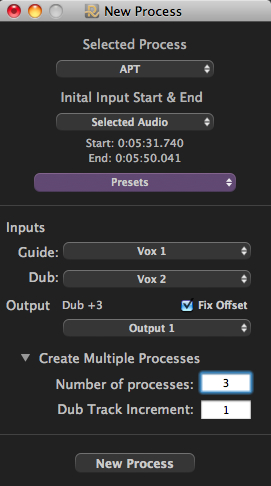 This is done by using the simple controls added with Create Multiple Processes in the lower part of the New Process window shown at right. The top controls tell Revoice Pro (similar to as before):
This is done by using the simple controls added with Create Multiple Processes in the lower part of the New Process window shown at right. The top controls tell Revoice Pro (similar to as before):
- Which Process to use on all the input tracks
- What range of audio to process in all tracks
- Which track is the Guide Track for all the Dub tracks
- Which track is used as the first Dub track
The new controls to Create Multiple Processes set:
- Which and how many input (Dub) tracks to process, and
- Where to put the output track
Once this information is setup, pressing the space bar will make Revoice Pro automatically:
- Create and insert the appropriate Process Control Blocks
- Processes the audio into the designated Output tracks, and
- Start playback
This feature can be used, for example, to:
- Instantly tighten the timing and/or pitch of 2, 3 or more recorded versions of a lead vocal ("stacked vocals") to the best "guide" lead vocal (which could be a different singer).
- Instantly create stacks of time-aligned harmony tracks (to one Guide Harmony for pitch and/or time or to the lead vocal for timing).
All of the above also applies to processing monophonic (single pitch) instrument tracks.
NOTE: In this chapter, screen images may not have the have exact appearance of Revoice Pro 3, but the procedures described will be correct.
Back to Index
How to create Multiple APT processes using the same Guide Audio
As explained in the previous chapter, Revoice Pro Sessions can hold an unlimited number of tracks. This allows multiple versions (groups or "stacks") of individual lead or harmony vocal or instrumental tracks to be loaded into Revoice Pro.
Revoice Pro has simple, dedicated controls for quickly and automatically creating multiple groups of APT functions at the same time that use the same Guide Input track and generate one processed output per Dub input.
In addition, using the Warp functions described here, the time and pitch of Lead and Harmony Guide tracks can be modified first in Revoice Pro for creative or corrective purposes. The advantage of doing this in Revoice Pro is that further modifications to Guide tracks will be automatically passed along to other tracks using the Guides' timing or pitch information.
Important Concepts Before Setting up the Multiple Group Processes
- It is important to understand that each time multiple APT processes are created automatically for a group of tracks, each of the APT processes will be give the same selected Preset settings for the APT. This Preset needs to be set before generating the outputs. If a Preset is not selected, the User Default Preset will be used.
- However, once the APT Process Control blocks are created (i.e. before or after processing), the individual APT processes settings for each Dub can be independently modified if required.
For most efficient use of this feature, the user should also know (from previous chapters) how to:
- Import audio and Export multiple tracks of processed audio
- Create and name new Tracks
- Use Revoice Pro features for APT and other processes to fix any problems
- Modify and Save process Preset settings
- Change the heights of the displayed tracks
- Audition individual process inputs and outputs
- Display only single processes
Back to Index
Step by Step Procedure for Automatically Creating Multiple APT processes
 Input a Guide and any number of Dub (input) tracks that are to be modified by APT processes at the same time.
Input a Guide and any number of Dub (input) tracks that are to be modified by APT processes at the same time.
Example: Shown right are 4 tracks containing input audio. One Guide (Vox1) and three Dub tracks (Vox2, Vox3 and Vox4) have been loaded with audio regions with similar names).
TIP: If clipping is heard when playing multiple tracks simultaneously, set Revoice Pro's Master Volume control lower (e.g. to -6 dB).
- Create the APT Output tracks needed (if they are not in the session).
Each APT process will need an Output track.
TIP: As shown in left figure below, it is most efficient use the Add Tracks command in the Track menu. That will bring up the New Audio Tracks windows shown right. Put the number of new (Output) tracks required and type the desired name (with optional number) for the first Output track.
Example: We need 3 Output tracks for the 3 Input (Dub) tracks to be processed (Vox 2, Vox 3 and Vox 4). The first Output track will be named Output 1 - which means the other track names will be incremented automatically.


- Press the "Add" button in the "New Audio Tracks" menu (above right) to create the 3 new Output tracks.
TIP: While tracks are full height and the pan controls are showing, it is a good time to set any pans or volumes.
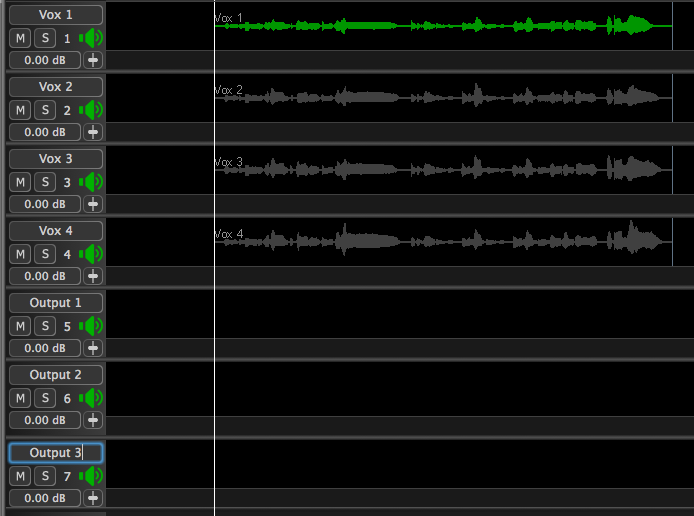 Example: Note that the new Tracks added at the bottom are automatically labelled Output 1, Output 2 and Output 3.
Example: Note that the new Tracks added at the bottom are automatically labelled Output 1, Output 2 and Output 3.
OPTION: In picture at right, we have fit all the tracks into the Session window. To do this, hold the SHIFT key down, select a track separator line under any track and drag the separator upwards to reduce the heights of ALL the tracks together to fit in the Session window, as shown in the image.
NOTE: If a Track name field is selected (as shown in the picture at bottom left with Output 3 highlighted in blue) then click inside the Session window to deselect the name field so that any further keyboard commands are received correctly.
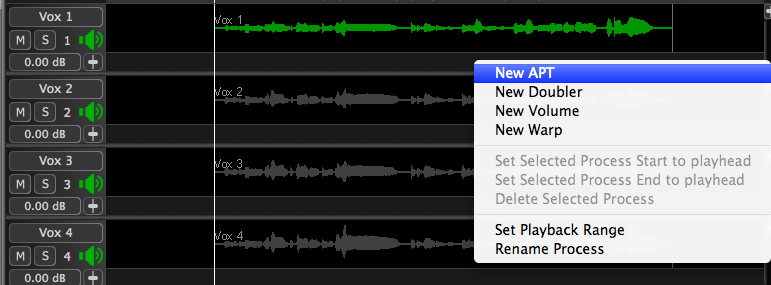 Open the New Process window by either
Open the New Process window by either - Pressing the keyboard "B" key or
- RIGHT CLICK in a Process Control track to bring up the menu shown right, select New APT and release.
- This will open the New Process window as shown below.
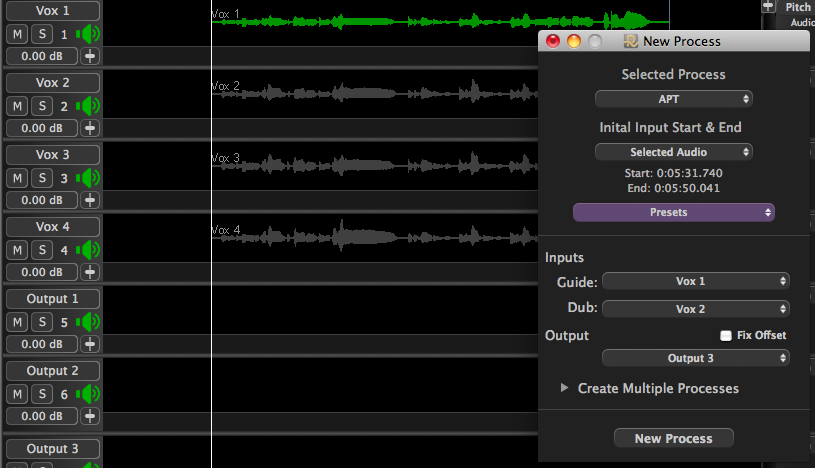
- Check that the selections in the New Process window are correct and change ones that are not.
NOTE: These fields are filled in automatically and may be correct upon opening. In this example the following are correct:
Selected Process: "APT".
Initial Input Start and End: "Selected Audio".
Inputs Guide: "Vox 1".
Inputs Dub: "Vox 2".
But this is not. Output: "Output 3"
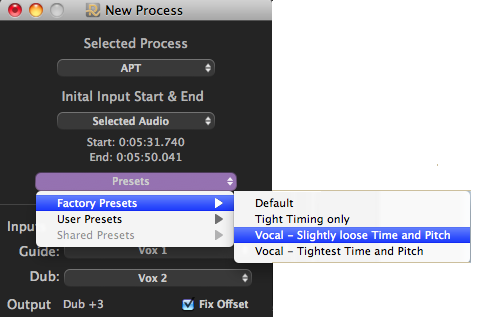
- Set the Processing Preset (Optional)
As shown in image at right, Presets has been selected and the menu setting "Vocal - Slightly Loose Time and Pitch" has been selected for this example. If a Preset is not selected, the "Default User Preset" will be selected.
The processing setting for each individual APT can be modified later as well.
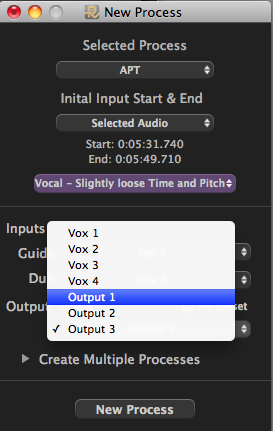 Use the "Output" drop down menu to select the track that will receive the first of the multiple APT outputs.
Use the "Output" drop down menu to select the track that will receive the first of the multiple APT outputs.
Example: Note in the first image above of the New Process window, the track labelled "Output 3" was selected (because it was the last new track created). But we want the first APT Output from the track labelled "Vox2" to go to the track labelled "Output 1".
In the figure shown right, we have clicked in the Output dropdown control and selected the track "Output 1", which will be shown in the next image below as the selected Output track.
- In the New Process window, click the triangle next to "Create Multiple Processes" to show the fields "Number of processes" and "Dub Track Increment" and set these two fields as shown below.

In this Example left:
"Number of processes" - has been set to 3, to create one APT for each of the three Dub inputs.
"Dub Track increment" - has been set to 1, because the second Dub input (Vox 3) is one track below the first Dub input ("Vox 2").
- Click the Output "Fix Offset" tick box to maintain the offsets between each Input Dub Track and the APT Output Track.
Example: As shown in image above, once Fix Offset is set ON, the text next to Output shows "Dub+3". This means that each APT Output will be sent to the track 3 tracks below each corresponding Dub Input Track.
This will be shown executed in the next step.
TIP: Before creating the New Processes, make sure that one of input audio regions are selected (green) (as shown in the figure in Step 4) to ensure that the range of the audio to process is specified correctly.
- Create the New Processes by pressing the keyboard "N" key or clicking the "New Process" button.
Example: As seen below, three APT processes have been created, all of which use "Guide Vox 1" as the Guide input.
The Process Control Blocks are all the length of the audio that was initially selected.
The Dub Process Control Blocks have been inserted (with 1 track spacing) into Tracks Vox 2, Vox 3 and Vox 4.
The 3 output ranges have been "reserved" in the Output tracks "Output 1, 2 and 3" which are 3 tracks below each APT process Dub Input track, and the red lines at the tops of the output tracks show the processing has not yet been run).
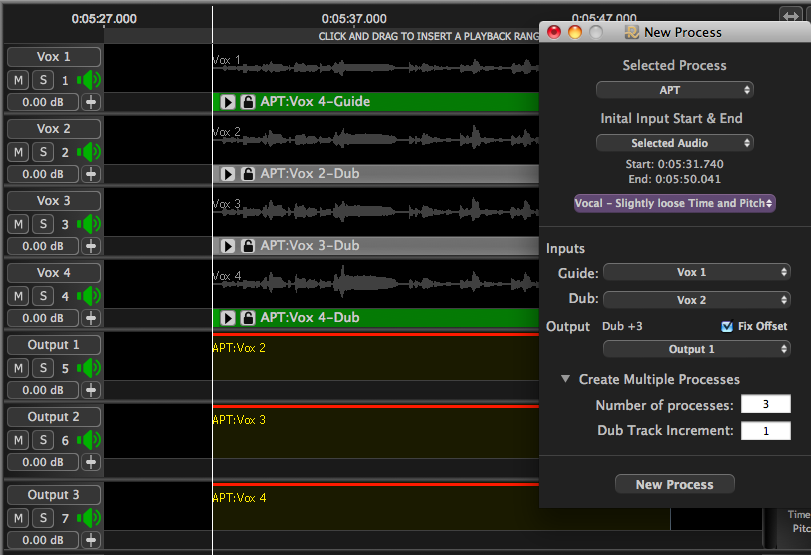
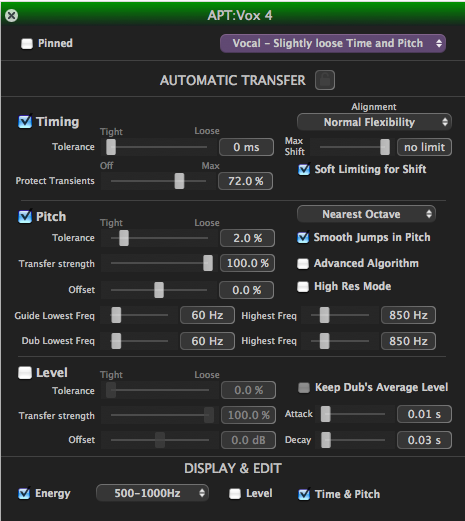 OPTION: Before or after processing, you can inspect any of the APT process settings
OPTION: Before or after processing, you can inspect any of the APT process settings
Do this by clicking an a Dub (or Guide) process control block and pressing the keyboard P key (or clicking the black triangle in a Process Control Block shown above).
TIP: If the APT process Settings are not correct, you can:
a) Change the processes settings to what is desired, and save these as the Default User Preset.
b) Then, use UNDO commands until you UNDO the insertion of the multiple Processes.
c) Then return to Step 11 and recreate the processes.
- Press the spacebar to run the Multiple APT Processes, create and play the Outputs
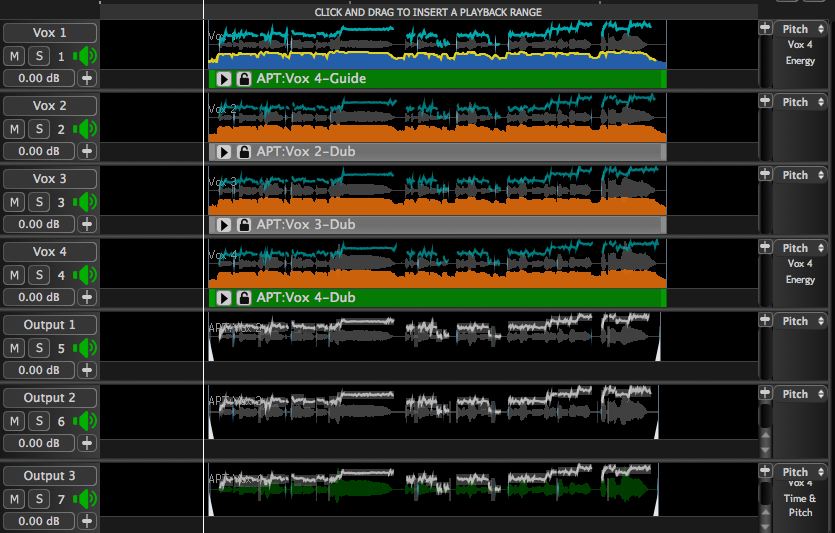 Example: As shown at the right, the three APTs processes have been run and there is now processed audio in tracks Output 1, Output 2 and Output 3.
Example: As shown at the right, the three APTs processes have been run and there is now processed audio in tracks Output 1, Output 2 and Output 3.
TIP: To set up auditioning of just the multiple Outputs with the Guide Input, if the track count is under 10, you can press the keyboard numeric keys to toggle the solos on (or off) for tracks 1, 5, 6 and 7, or any other combinations. For tracks with number above 10, then you can click the Solo or Mute buttons in the Track.
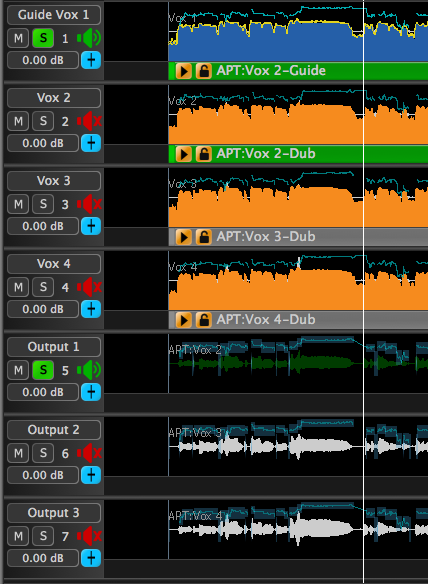
However, the Process-based Solo switching will be effective for any number of tracks. By selecting either a Process' output audio or an APT's Dub Process Control Block then, using Quick Keys as described in detail here, the Inputs and Outputs of that APT can be Soloed in any combination. For example, in the image below (where APT Vox 2-Dub is selected) the E key on the keyboard Solos the Guide Input (In track 1) and the Output 1 in track 5 containing the processed APT Vox 2-Dub.
TIP: Reminder - How to view one APT's tracks.
When the APT input and output tracks are spread out in a session as shown below on the left, the best way to help audition and work with one APT at a time is to zoom in on the APT. To do this, select either the Dub Process Control Block or Output audio of the APT of interest, and press Z on the keyboard. This will hide all tracks except the Input Guide, Dub and Output tracks for that APT process.
If you want to increase the height of the shown tracks, also select the commend File /Auto Size Track Heights which is shown on the right. Pressing X restores all the processes to view. Click here for more details.
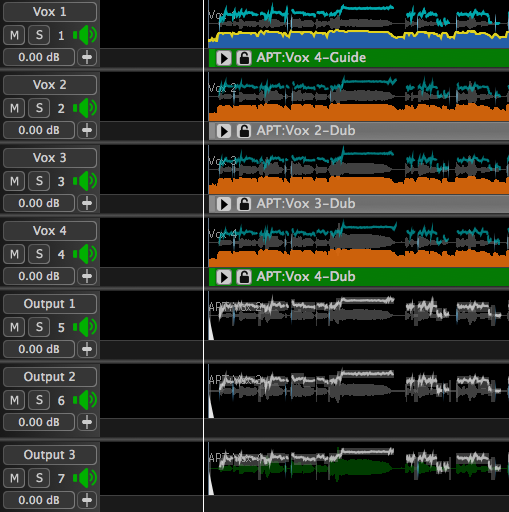
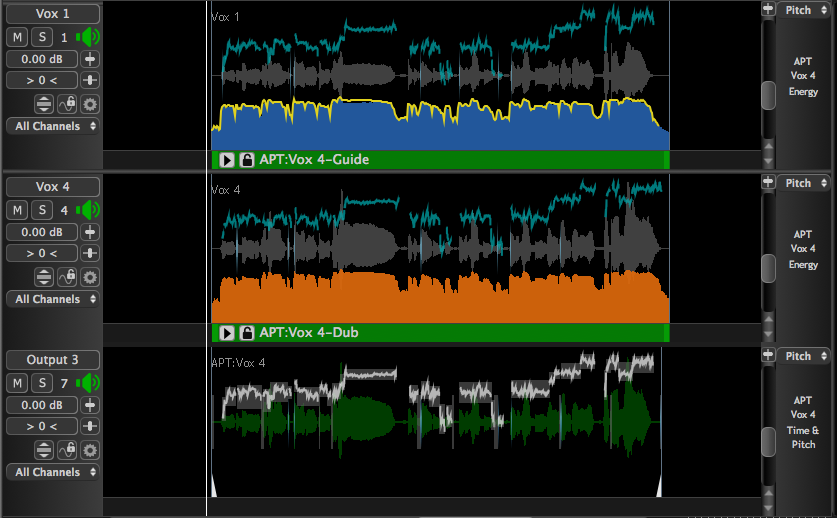
Setting up Multiple APT Processes with each Output track below a Dub Input Track
An alternative to the above example of track arrangements in which groups of Dub Inputs were followed by groups of Output tracks, is to put each Output track below its Dub Input track. Creating Multiple APT processes in this case is once again straightforward.
Example: The main difference in this arrangement as shown below left is that the Dub inputs (Vox 2, Vox 3 and Vox 4) are two tracks apart (i.e. in tracks 2, 4 and 6). Each of these input tracks is followed by a track (Output 1, Output 2 and Output 3) that will receive the APT processes' output (into tracks 3, 5 and 7).
This arrangement simply requires that in the New Process window, we have to set Dub Track Increment to be 2.
If, as before, we want to create 3 APT processes (one for each Dub input), the Number of processes is again 3.
When we turn the "Fix Offset" ON, then we see the APT Output will go to the number of the Dub track + 1.
After the keys N and Space Bar are pressed (to create and run the processes), the result is shown in the right hand picture, with the APT Dub Process Controls on the Input tracks and the corresponding Output tracks being correctly placed.
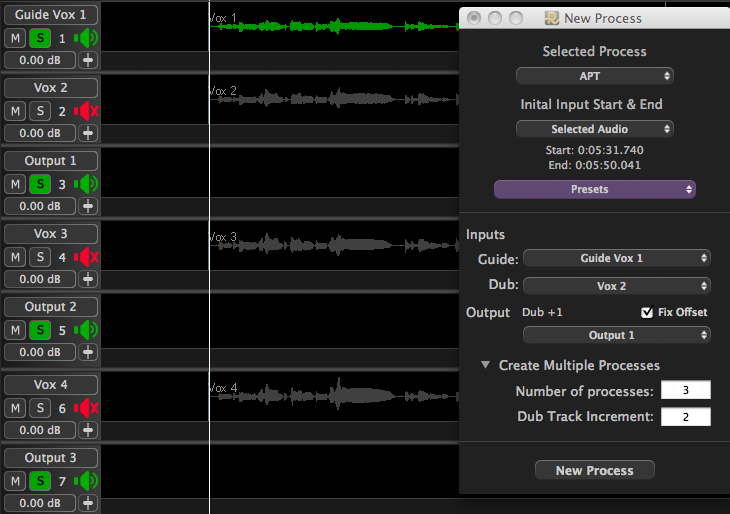
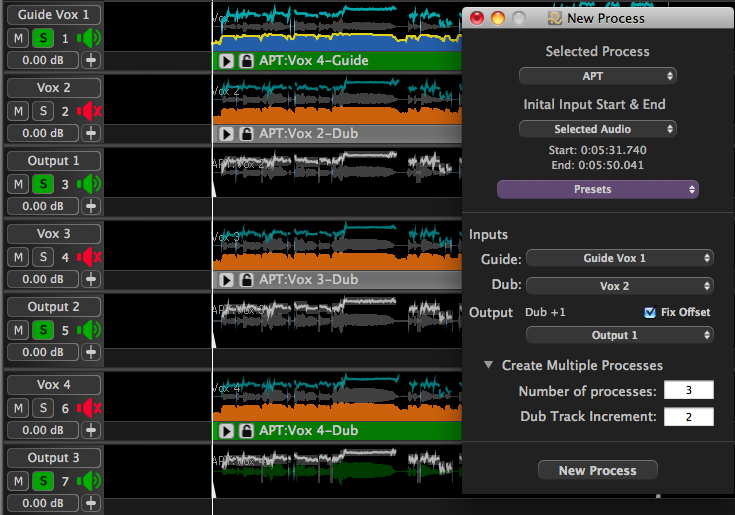
Important Additional Processing Information
TIP: Ensure the keyboard and mouse input goes to the correct window.
The New Process window "floats" and, like the Revoice Pro application, can accept commands by mouse clicks and typed input. However, selecting this window deselects the main Revoice Pro window.
When the New Process window is selected, before commands can be received by the Revoice Pro Session window, it is necessary to click once inside or at the top of the Revoice Pro application window to select it (as the "focus"), before issuing further mouse click or keyboard commands into the Revoice Pro main window or menus.
Similarly, after changing number of Tracks in the Add Tracks command, before clicking New Process (or pressing N), reselect one of the tracks audio signals.

